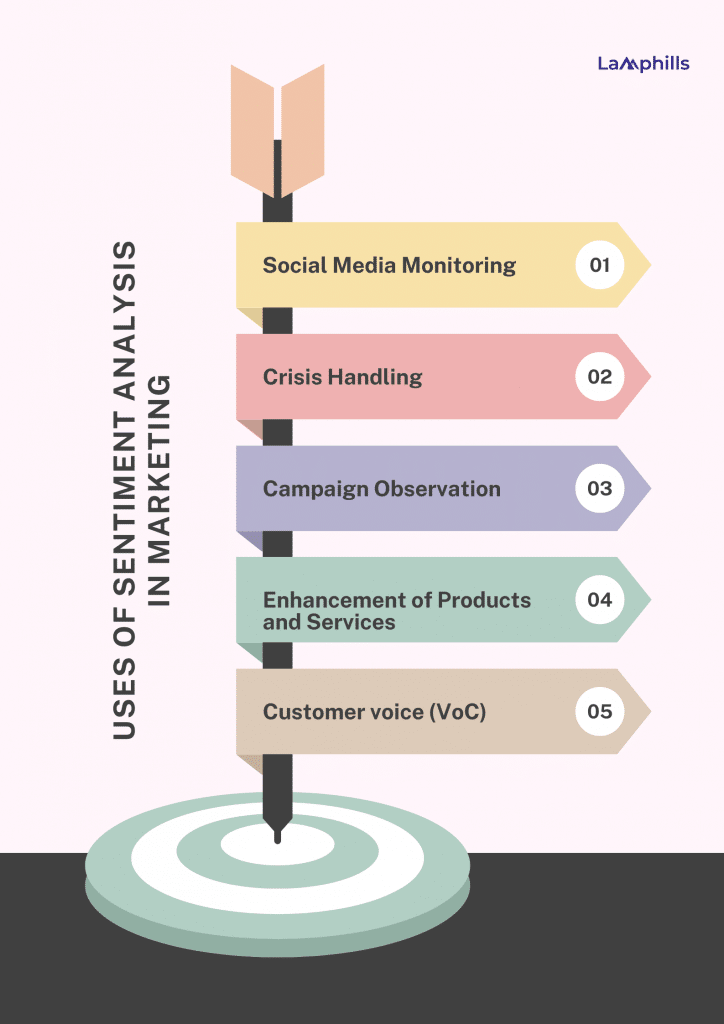As a writer skilled in corporate social impact, I’m constantly asked to explain one of today’s largest marketing trends on brand sentiment. Like I will always say, the key to delivering effective campaigns is knowing who your target audience is. Knowing their opinions about your company, goods, and sector will help you make an educated guess about what it will take to create an effective campaign.
It’s critical to extract as much information as possible from the feedback you receive. Without sentiment analysis, you can only fully grasp a small portion of the larger picture.
I’ll be concentrating more on the applications of social sentiment analysis for marketing professionals in this 2024 guide, including definitions, advantages, examples, how-tos, and helpful hints.
This article will also teach you how to use sentiment analysis to increase the effectiveness of your marketing plan.
Key Takeaways
- To conduct an effective sentiment analysis, information must be gathered from a variety of sources, such as social media, forums, review sites, and direct consumer feedback.
- Using sophisticated sentiment analysis techniques that make use of NLP can aid in precisely identifying and classifying the emotions that are represented in a variety of texts.
- Accurate Sentiment analysis goes beyond just identifying keywords. To prevent misinterpretation and obtain genuine insights, it entails comprehending the context in which feelings are communicated and taking into consideration subtleties like sarcasm, irony, and cultural differences.
- The ultimate objective of sentiment analysis is to convert conclusions into workable corporate plans.
- The perception of a brand is fluid and subject to quick shifts. By keeping an eye on changes in public opinion and reacting quickly to new trends, brands can stay informed and make sure their strategies are still effective in upholding a strong brand image.
What Is Brand Sentiment Analysis
Brand sentiment analysis is referred to as any media reference to your brand and the underlying emotions that accompany it. Sentiment analysis is a frequently used tool in PR to monitor the effectiveness of this word-of-mouth brand awareness campaign over time. This artificial intelligence-driven tool uses context and emphasis to categorise opinions as positive, negative, or neutral.
It can give you a rapid overview of how well you’re viewed by target audiences or customers by amassing these opinions at scale.
Techniques for Brand Sentiment Analysis
If you’re wondering how to gauge brand sentiment, just take these four simple steps I use every time:
#1. Use Social Media Monitoring Tools
Using social listening tools is the simplest approach for brand managers, social media marketers, and brand owners to do sentiment analysis on social media. These programs automatically search social media for mentions of brands, goods, or services and categorize them as neutral, favourable, or bad.
Without requiring a background in data science or natural language processing, non-technical you can easily harness the power of sentiment analysis with social listening and analytics tools like Sociainsider.
#2. Examine, Plan, and Maximize
In this aspect, I will advise that you begin categorizing them for analysis once you have a clear sentiment classification. In-depth resources provide you with sentiment-organized clickable information in addition to important metrics like reach and interaction rates. You may then plan your next action and make your PR initiatives more effective.
Effective brand planning and customer relationship management needs social listening, sentiment analysis, and customer feedback management.
#3. Determine the Platforms that Your Intended Audience Uses to Pass Their Time
Decide which social media platforms are most appropriate for your company before searching through the social media landscape for every mention, good or bad.
To achieve this, you will need to conduct some additional research on social media, including studying rivals and your niche.
#4. Compile a List of Brand Mentions or Pertinent Keywords
You can begin investigating the most popular and pertinent keywords and brand mentions once you’ve properly determined who your target audience is. You can begin by adding a hashtag using a social listening service, and then search for trending, relevant hashtags and keywords.
Why Examine Branding Sentiment Analysis?
In addition to businesses, public figures and PR firms also utilize sentiment analysis to manage their reputations and learn what their customers are saying about their goods and services.
The following are the key factors that make sentiment analysis a valuable tool for your brand:
#1. Recognizing the Views of the Public
Brands can monitor public opinion about their goods, services, and general image by using sentiment analysis via social media.
By learning important details about what customers like and hate through indirect feedback, businesses can better understand their target market and make necessary adjustments.
#2. Improving Client Satisfaction
Brands can find areas of their business that require improvement by using feedback gathered from the study of social media comments.
By tackling these concerns, businesses may improve customer satisfaction, loyalty, and retention.
#3. Evaluating the Success of a Campaign
Metrics measuring brand sentiment are useful tools for assessing the success of PR and marketing initiatives. Brands can assess how successful a campaign is in changing public image or enhancing brand sentiment by comparing sentiment before and after the campaign.
#4. Identifying Patterns
Social media sentiment research powered by AI has the potential to forecast changes and patterns in customer behaviour over time. Having this kind of foresight can help you stay ahead of the curve, make proactive strategy adjustments, and take advantage of market possibilities.
#5. Analysis of Competitors
Sentiment analysis from social media platforms can also be used to track rivals’ positions in the market. It can reveal strategic benefits and chances for differentiation and assist in understanding how customers feel about the goods and services offered by rival companies.
#6. Preventing and Managing Crises
By keeping an eye on social sentiment, organizations can promptly spot unfavourable patterns or comments that have the potential to turn into a disaster. Early identification enables companies or public figures to quickly address the problem, lessen the harm, and avert possible PR catastrophes.
#7. Examining the Consumer Voice (VoC)
The customer’s voice includes feedback gathering, data analysis, and action planning. VoC is in charge of comprehending how customers perceive and interact with your brand and merchandise. Positive outcomes from social sentiment analytics are more likely to point to improved customer relations.
Social media sentiment research offers a wealth of useful information that can greatly improve many facets of corporate operations.
#8. Customizing Communications and Marketing
More individualized and successful marketing strategies can be sparked by the insights obtained from social media text analysis. Social media marketers can achieve higher engagement rates by customizing their messaging, campaigns, and content to match the preferences and moods of their audience.
#9. Identification of Influencers
Social media monitoring, sentiment analysis, and brand monitoring provide quick and straightforward influencer identification, ranging from micro-influencers to essential opinion leaders.
#10. Product Development and Market Insights
By exposing consumer preferences, demands, and market gaps, sentiment analysis can be used as a type of market research. Metrics from sentiment analytics can direct innovation, enhancements, and new product creation.
Examples of Brand Sentiment Analysis Use Cases
Brand sentiment analysis may revolutionize enterprises when used effectively. Now let’s explore some real-world applications that highlight its enormous potential.
Uses of Sentiment Analysis in Marketing
Giving your customers a place at the table so you can receive their direct, honest opinions is what sentiment analysis is all about. Gaining insight into your client’s current feelings about a topic can help you create more effective conversion routes, make wiser financial decisions, and improve your rapport with them.

#1. Social Media Monitoring
Utilize sentiment analysis in conjunction with social media listening to decipher what people are saying on social media about your product, brand, or market segment.
Your sentiment analysis program will analyze social media postings and comments to determine the sentiment, opinions, and scores expressed. This makes the process of figuring out how consumers feel about your brand or other subjects more uniform.
By creating campaigns that consider customer sentiment, marketers may incorporate these insights into their social media strategy. Including the thoughts and feelings of your target audience demonstrates that you are paying attention to them and that you care about them. Increased engagement and stronger connections may result from more individualized campaigns.
#2. Crisis Handling
Frequent brand sentiment analysis can also act as a crisis early warning system. You have the opportunity to correct any bad opinions before they get out of control by actively monitoring brand sentiment.
In a similar vein, sentiment analysis can assist you in determining the consequences and guiding your crisis management plan in the event of a catastrophe. You’ll be more adept at preserving your reputation by acting appropriately the more you grasp the feelings that underlie discussions about your brand.
#3. Campaign Observation
Brand sentiment analysis I will say is a fantastic tool for monitoring and evaluating the effectiveness of your efforts. Do customers find the campaign exciting and engaging, or are they left feeling let down or perplexed? Knowing these feelings enables you to adjust your messaging and approach so that your campaigns have the desired effect on your target audience.
Checklist for Effective Brand Sentiment Analysis.pdf
#4. Enhancement of Products and Services
Online consumer reviews of your goods or services can also be used for sentiment analysis to identify problems with your items. This enables you to identify reoccurring problems and take proactive measures to resolve them. For example, you can give fixing a particular issue a top priority if you find a trend of bad sentiment surrounding it.
Recent talks regarding the airline were primarily unfavourable, as evidenced by the sentiment analysis below, primarily sparked by the term “lost luggage.” The firm can then use this information to guide its future initiatives, which might include enhancing its baggage handling protocols or offering superior customer service to clients who misplace their luggage.
#5. Customer voice (VoC)
VoC is an acronym for customer journey feedback. Utilizing VoC programs, brands create products and marketing plans that cater to the requirements and desires of their target demographic. Using sentiment analysis for VoC analysis may improve customer satisfaction and spur company expansion.
Sentiment analysis software can be used to analyze customer reviews, surveys, CRM notes, and other sources in real-time. This enables you to recognize an issue or an opportunity and then promptly modify your marketing plans to suit your target audience’s requirements and preferences. Maintaining alignment with client expectations cultivates stronger bonds and increases customer loyalty.
How can Brand Sentiment be Strengthened?
When negative or neutral sentiment is detected, action must be taken to improve brand sentiment. Not only should you continuously analyze the mood surrounding your brand, but you should also continuously update and respond to the results.
Consider the following proposed actions:
#1. Improve the Efficacy of Your Customer Service Staff Training
You can see which subjects elicit a negative response and which acts elicit a positive response by utilizing sentiment analysis on all of your channels, including social media, customer support, and other channels. With this information, you can better serve customers, train your customer support teams, and ease the workload of your staff members by providing them with data-driven activities to complete.
#2. Enhance Your Business Procedures Quickly
Additionally, you can enhance areas that elicit unfavourable attitudes or business operations. If customers consistently have bad things to say about your customer service department, make adjustments and inform them of these developments to assist turn this negative feedback around.
#3. Thorough Product Examination
Additionally, you can examine and comprehend potential areas for improvement in your products, especially if modifications are required for distinct customer segments. By using this data, you can better tell your product teams about changes that will be more well-received and, ultimately, boost brand sentiment and perception.
#4. Fulfil and go Beyond the Expectations of the Customer
You can quickly find out what subjects and trends your customers are interested in with thorough media monitoring and sentiment research on social media. Positive feedback from your customers can be replicated, or you can just market their ideas more successfully. For instance, offering free shipping can increase the likelihood that a customer will suggest your business, keep them loyal, and create positive brand sentiment. By adopting this change and informing your customers of it, you can significantly boost the health and sentiment of your brand.
#5. Examine what your rivals are doing successfully
It’s not enough to monitor how people perceive your brand; you also need to consider how your competitors may be seen. You may learn what your rival businesses are doing successfully and where they are falling short of expectations by using your sentiment analysis of social media and other channels. By focusing on their weak points—such as unfavourable opinions about prices or customer service—and turning them into a differentiator for your business, you can win over their customer base.
#6. Examine the Responses to Particular Brand Campaigns
An excellent technique to gauge the effectiveness of your marketing plan and how your target audience is responding to it is through campaign performance analysis. Measuring brand sentiment allows you to find out if a marketing campaign is enhancing people’s perception of your brand in addition to determining whether sales have grown.
#7. Close the Gap with Disgruntled Customers
Customers may voice their opinions online if they aren’t receiving the desired brand experience. You can identify areas where your team can publicly shut the loop by using sentiment analysis. This benefits not just those particular customers, but also serves to show that your brand values customer satisfaction. Make sure you get in contact as soon as possible to address the issue and provide a significant solution.
#8. Take Note of Previous Campaigns
Examine the factors influencing your interaction on all of your channels, determine how they affect sentiment, and utilize this information to modify your marketing. Does brand emotion respond better to video than to static ads? Does spreading a certain message have a greater impact? Which subjects attracted the greatest attention to your brand? You may efficiently transform social media sentiment analysis and more into ideas for future ads by turning on brand listening regularly.
How do you measure brand sentiment?
Sentiment analysis tools can instantly alert you to any negative mentions. Certain technologies, such as Awario, can classify mentions as neutral, negative, or positive and display sentiment evolution over time. Clarabridge’s clause-level sentiment analysis can aid in more precisely capturing sentiment variations.
What companies use brand sentiment analysis?
Businesses use brand sentiment analysis to track social media sentiment about their brands, better understand customer opinions, and enhance customer experiences. Additionally, it can support investment choices and market analysis.
How do we monitor brand sentiment?
Tracking keywords, hashtags, and mentions regarding a company, product, or sector on many social media sites can help you monitor brand sentiment. We refer to this procedure as social media monitoring. In addition to inspiring fresh content and marketing initiatives, it can assist in measuring KPIs such as brand sentiment and satisfaction.
Conclusion
These are only a handful of the numerous applications for brand sentiment analysis. As you can see, turning those insights into actions is just as important as simply knowing how your audience feels. Thus, now is the perfect moment to use brand sentiment analysis if you haven’t already. Investigate the available resources and methods, and begin paying attention to the feelings and viewpoints of your audience. The narrative surrounding your brand is a dialogue, and the secret to developing it is sentiment research.
Related Articles
- 11 Insane Brand Tracking Tools Will Blow Your Company’s Profits
- HOW TO MEASURE BRAND REPUTATION IN 2024 (MY EXPERT TIPS)
- What is Share of Voice? A Comprehensive Guide to Measuring Your Brand’s Market Presence
- MEDIA ANALYSIS: How To Conduct An Effective Media Analysis
- How To Measure Brand Awareness: KPIs To Look Out For






